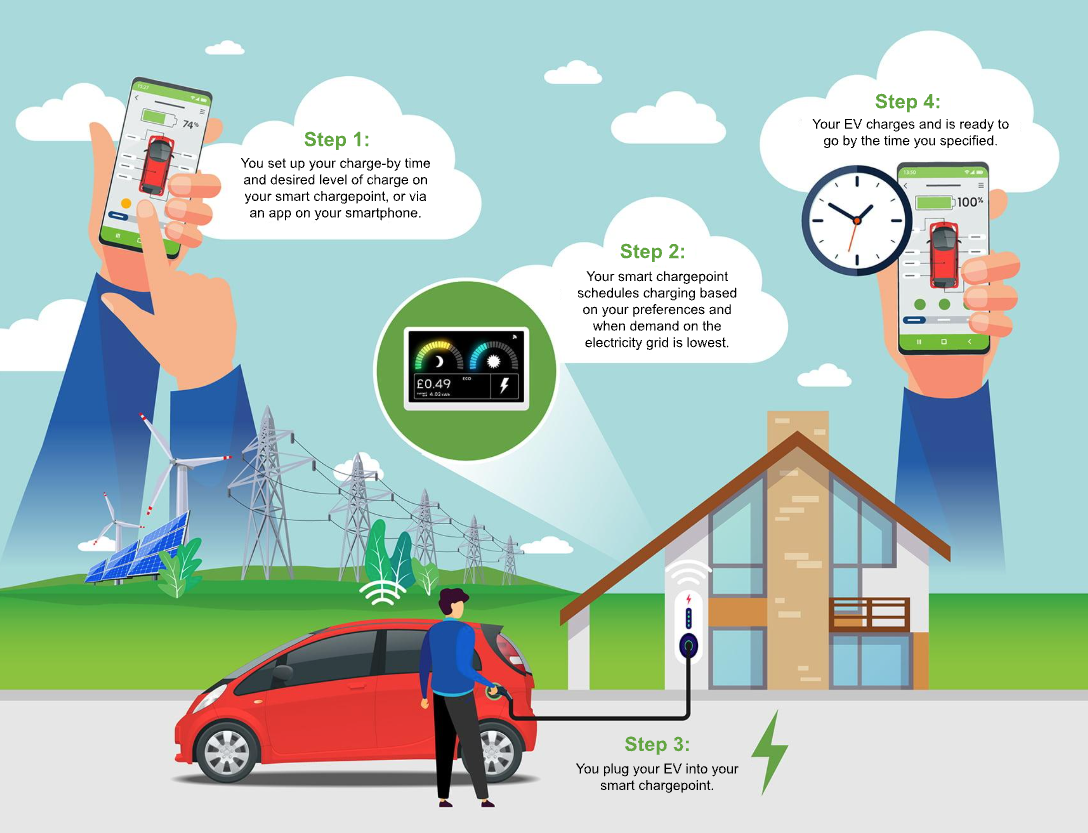Introduction
By 2030, there are expected to be over 245 million Electric Vehicles (EVs) on the world’s roads, as countries across the globe accelerate their transitions to net-zero emissions [1]. This growing fleet will account for a significant share of global electricity demand, creating challenges and opportunities for the energy sector. If we are to phase out internal combustion engines and achieve meaningful reductions in carbon emissions, we must ensure our energy infrastructure is ready to manage such a load. That means reducing dependence on costly, imported fossil fuels and expanding access to clean, renewable electricity. But solving the supply problem is only part of the equation. We also need intelligent, adaptive systems that can deliver energy where it’s needed, when it’s needed, and at a price people can afford.
Smart EV charging plays a crucial role in this vision – whether it happens at home, at work, or in public spaces. It enables the use of greener electricity, empowers drivers to charge when energy is cheapest and cleanest, and even opens the door to vehicle-to-grid solutions that return power back to homes or the grid. In doing so, smart charging helps reduce overall system costs, ultimately lowering energy prices for everyone.
What is EV Smart Charging?
An EV smart charging system is a solution for managing the charging of electric vehicles in terms of when and how power is delivered to the vehicle. Unlike an ordinary charger that starts drawing power as soon as the EV is plugged in, smart chargers decide when to deliver power and at what rate based on the energy cost, grid capacity, and driver’s needs. This approach allows for real-time monitoring, controlling, and adjusting of energy use. It requires the EV to be connected with the charger and the charger to the cloud management system while also being connected to the grid.
In the case of a home setup, smart chargers typically connect to the internet, which allows them to communicate with mobile apps and some energy providers. The device serves to connect the EV to the home electricity system and may also interface with the grid. With the app, drivers can program when the car should charge to bypass peak energy rates and have the vehicle ready when they need it.
⚡ What is Smart Power Management for EV Charging?
Integration of power management in EV smart charging includes intelligently managing grid capacity, energy prices, renewable energy availability, on-site storage, driver energy autonomy, and many other factors. By automatically and dynamically controlling energy flow, we ensure vehicle charging is both sustainable and efficient.
The requirement
Most EV drivers will do most of their charging overnight at or near home, so this article will focus on drivers that use their domestic energy supply. However, the EV owners’ household electricity bills will increase if they are predominantly charging at home. In reality, EVs only charge for 19% of the time they are plugged in at home, providing an opportunity to shift demand away from typical plug-in times when demand is already high. This provides an opportunity to shift demand away from typical plug-in times to times when the electricity network is less congested. Such smart charging power adjustments will not inconvenience the EV driver but, by helping to efficiently balance the electricity system, will make their vehicle charging costs cheaper.
In simple terms:
If the customer plugs in their vehicle to charge when they get home from work at, say, 6:00 p.m. – a time when both demand and the carbon intensity on the grid are at their highest – their vehicle should then be smartly charged at the lowest cost and greenest periods throughout the night, ready for when they need it in the morning.
In this article, we will focus on how Zartis has collaborated with a leading cleantech software company, and how our engineers are playing a key role in building a resilient, real-time power management solution for smart EV charging. We’ve been working with this client across different teams and products since 2019, and currently we have 16 software engineers helping them empower some of the biggest energy suppliers to better serve millions of customers.
Methodology
In a home setting, the economic savings can be realised by synching charging times to the cheaper periods of a flexible energy tariff. The developed platform receives wholesale electricity pricing data in real time and combines it with the network price feed and other supply costs. The platform will choose to shift EV charging away from peak times on the network based on the pricing signals it receives, unless overridden by the end user. Optimization algorithms will then take control of EV charging so that it occurs at times of low wholesale price, or times when abundant clean energy is on the grid.

Figure 1: How to smart charge. Image source: UK Power Networks, Project Shift Report (2022)
Smart Power Management in Action
The implementation of the Smart Power Management system for EV charging has been based on these pillars:
Device Integration
Integrations are established with leading Electric Vehicle Supply Equipment (EVSE), which is an electric vehicle charger and Auto OEM (Auto Original Equipment Manufacturer), which is a vehicle manufacturer. Connectivity with both vehicle telematics and charge points is enabled to ensure comprehensive access to data and control.
The idea is that telemetry data gathered from the OEM APIs are fed to an optimization engine and then commands like START, STOP or CHARGE-SCHEDULES (e.g. charge from 1pm to 4pm) are sent to the vehicle using the established integration.
⚙️ Energy Optimization
Real-time optimization algorithms are developed for diverse device types, driven by wholesale price forecasts and dynamic demand response signals.
The optimization engine integrates data from electricity markets, including tariff prices and grid carbon intensity, as well as device-level inputs like consumer preferences, battery state-of-charge, weather forecasts, and utility rates.
User Experience
A mobile app working on the “set it and forget it” smart charging experience [2]. It separates EV charging costs from the rest of the home’s electricity usage and credits customers monthly for optimized charging. Users no longer need to monitor energy prices or charging times manually – the platform takes care of it, ensuring vehicles are charged when electricity is cleanest and cheapest, often during periods of high renewable generation.
Data & Insights
Transforming device and market data into meaningful insights to enable a better understanding of user behavior and program impact.
Key Telemetry Attributes & Their Role in Smart Charging
The analysis of telemetry data received directly from the vehicle plays a crucial role in the understanding of how the platform works and the decision-making process.
1. State of Charge (SoC): The current battery level of the EV, typically shown as a percentage (e.g., 60% charged). SoC is essential for determining:
- How much energy the vehicle still needs
- Whether the vehicle can delay charging (if SoC is high)
- When to stop charging (to avoid overcharging)
2. Battery Capacity: The total energy the battery can store (kWh), and the portion of that energy that’s usable for charging/discharging. Different EVs have different battery sizes and usable energy limits. Smart charging needs this to:
- Estimate how long it will take to reach full charge
- Calculate how much energy to deliver
3. Rate of Charge (RoC): The current power being delivered to the vehicle (e.g., 7kW, 50kW).
Real-time RoC helps systems throttle or ramp up charging
4. Driver Preferences / Schedules: User-defined settings like: “Charge by 7am”, “Only charge to 80%”, “Only use solar energy”
Makes charging smarter and user-friendly – aligning grid flexibility with real-world behavior.
5. Plug-in / Plug-out Events: When the vehicle is connected or disconnected from the charger. Helps systems react in real time – e.g., stopping optimization if the EV is unplugged early.
6. Location / Charging Context: The current location of the EV and type of charger (home or other). Determines whether charging should proceed.
Results
The smart power management system for EV charging of our partner has participated in several pilot studies. One of the most important ones was a project, led by a leading UK DNO, which ran for about 11months starting from November 2019 with the participation of about 300 EV users.
To better understand the initiatives and results of the study let’s take a moment to dive into the UK grid pricing system. In addition to your unit charges and other non-commodity costs, an electricity bill comes with Distribution Use of System (DUoS) charges. These charges cover the cost of installing and maintaining your local electricity distribution networks that deliver energy from source to end users. One of the most important factors of DUoS charges is the time of the day and is divided into 3 zones:
- Peak times (red zone) – the most expensive time to use electricity as demand is higher, during peak daytime hours between 4pm-7pm
- Off-peak times (green zone) – the cheapest time to use electricity as demand is lower, during the night
- Mid-times (amber zone) – a middle rate for times that are neither peak nor off-peak
The trial has divided the users into two groups, red band group (Group 1) and amber band group (Group 2). Both groups exhibited an evening peak reduction of around 55%. The below diagram shows the reduction in EV demand at peak times, comparing smart charging vs unmanaged charging.

Figure 2: DNO Trial – Normalized demand per EV [3]
The trial delivered in total 384 MWh of energy, of which 55% (215 MWh) was shifted, and delivered a total of 6.2 tonnes of CO2 savings.
Since the end of the pilot study, the smart charging platform has evolved significantly. Our partner has been providing a special energy tariff which splits the EV charging costs from home electricity charges and credits customers for the amount of electricity saved via EV smart charging every month. This special energy tariff allows customers to enjoy a low, flat rate for their EV charging that is separate from their household energy use. The estimated reduction of customers’ EV charging costs is around 70%, up to £500 ($617) annually.
Conclusion
This article has described how a leading cleantech software company, with the help of Zartis engineers, has implemented a real-time power management system for smart EV charging. The results of the first phase of the implementation were very promising. By reducing charging costs, the application helps lower the overall cost of EV ownership and supports the transition away from fossil fuels. For utilities, managed charging programs like the one described help mitigate the impact of EVs on the grid and better align charging demand with clean energy supply.
This platform has proved its robustness and is currently scaling to multiple energy providers worldwide, with a high number of EV market coverage and direct integration with most of the EV manufacturers.
Future work
Today, the vast majority of smart charging products control the timing and rate of charging in one direction only. In the future, more Vehicle-to-X (V2X) technologies will be available to consumers to offer bidirectional control to also enable discharging of the battery and export of energy to a home, a building or the grid (Vehicle-to-Home/Building/Grid) [4].
At its core, the EV battery becomes a form of distributed energy storage. While smart charging allows EVs to shift when and how they charge to meet demand, V2X (vehicle-to-everything) technology goes further, enabling multiple cycles of charging and discharging while the vehicle is parked. In the future, V2X will allow drivers to power their homes with their EV or use it as a reliable backup energy source during power outages.
—
If you have any questions relating to the topic or would like to collaborate on smart energytech projects, feel free to reach out!
Author:

References
- International Energy Agency – Global EV Outlook 2024
https://www.iea.org/reports/global-ev-outlook-2024/outlook-for-electric-mobility - Set it and Forget it: The Future of EV Charging https://sepapower.org/knowledge/set-it-and-forget-it-the-future-of-ev-charging/
- UK Power Networks – Project Shift Report (2022)
https://d1oyzg0jo3ox9g.cloudfront.net/app/uploads/2023/10/UKPN_Project-Shift_2022_Web-PDF-v2.pdf - UK Government – Electric Vehicle Smart Charging Action Plan
https://www.gov.uk/government/publications/electric-vehicle-smart-charging-action-plan/electric-vehicle-smart-charging-action-plan

